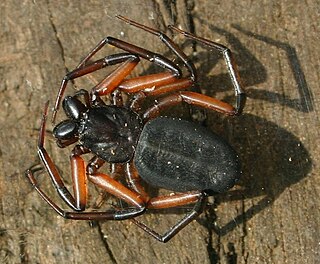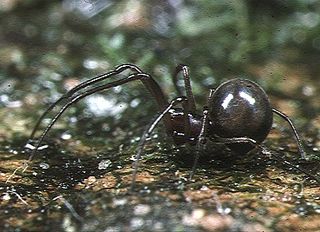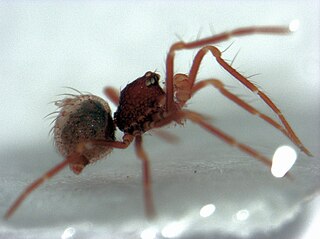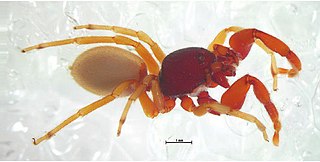
The family Dipluridae, known as curtain-web spiders are a group of spiders in the infraorder Mygalomorphae, that have two pairs of booklungs, and chelicerae (fangs) that move up and down in a stabbing motion. A number of genera, including that of the Sydney funnel-web spider (Atrax), used to be classified in this family but have now been moved to Atracidae.

Theridiidae, also known as the tangle-web spiders, cobweb spiders and comb-footed spiders, is a large family of araneomorph spiders first described by Carl Jakob Sundevall in 1833. This diverse, globally distributed family includes over 3,000 species in 124 genera, and is the most common arthropod found in human dwellings throughout the world.

Oonopidae, also known as goblin spiders, is a family of spiders consisting of over 1,600 described species in about 113 genera worldwide, with total species diversity estimated at 2000 to 2500 species. The type genus of the family is OonopsKeyserling, 1835.

Theridiosomatidae, commonly known as Ray Spiders, are a family of araneomorph spiders first described by Eugène Simon in 1881. The family includes 137 species divided between 20 genera. They are most recognizable for their construction of cone-shaped webs.

Trochanteriidae is a family of spiders first described by Ferdinand Karsch in 1879 containing about 52 species in 6 genera. Most are endemic to Australia though Doliomalus and Trochanteria are from South America and Plator is from Asia. Platyoides species exist in southern and eastern Africa, Madagascar, and the Canary Islands with one species, P. walteri, introduced to Australia.

Orsolobidae is a six-eyed spider family with about 180 described species in thirty genera. It was first described by J. A. L. Cooke in 1965, and was raised to family status from "Dysderidae" in 1985.

Stenochilidae is a family of southeast Asian araneomorph spiders that produce ecribellate silk. First described by Tamerlan Thorell in 1873, it now contains twelve described species in two genera.

Anapidae is a family of rather small spiders with 232 described species in 58 genera. It includes the former family Micropholcommatidae as the subfamily Micropholcommatinae, and the former family Holarchaeidae. Most species are less than 2 millimetres (0.079 in) long.

Archaeidae, also known as assassin spiders and pelican spiders, is a spider family with about ninety described species in five genera. It contains small spiders, ranging from 2 to 8 millimetres long, that prey exclusively on other spiders. They are unusual in that they have "necks", ranging from long and slender to short and fat. The name "pelican spider" refers to these elongated jaws and necks used to catch their prey. Living species of Archaeidae occur in South Africa, Madagascar and Australia, with the sister family Mecysmaucheniidae occurring in southern South America and New Zealand.

Holarchaea is a genus of South Pacific araneomorph spiders in the family Anapidae, and was first described by Raymond Robert Forster in 1955. As of May 2019 it contains only two species, H. globosa and H. novaeseelandiae, but there may still be undescribed species in New Zealand.

The Micropholcommatinae are a subfamily of araneomorph spiders in the family Anapidae. They were previously treated as the family Micropholcommatidae. Micropholcommatins are extremely small, with body lengths typically between 0.5 and 2 mm. They are usually found among leaf litter or moss.

The Palpimanoidea or palpimanoids, also known as assassin spiders, are a group of araneomorph spiders, originally treated as a superfamily. As with many such groups, its circumscription has varied. As of September 2018, the following five families were included:
The Archaeoidea or archaeoids are a group of araneomorph spiders, formerly treated as a superfamily. The unity of the group is rejected as of October 2015, with former members being placed in the Araneoidea and Palpimanoidea.

Coneweb spiders (Diguetidae) are six-eyed haplogyne spiders that live in tangled space webs, fashioning a cone-like central retreat where they hide and lay eggs. It is a small family, containing only two genera split between a range in the Southwestern United States and Mexico and a range in South America. Members of the genus Diguetia usually build their webs in shrubs or between cactus pads. They have the same eye arrangement as the venomous recluse spiders, but none are known to be harmful to humans.
Afrarchaea is a genus of African assassin spiders first described by Raymond Robert Forster & Norman I. Platnick in 1984.

Austrarchaea is a genus of Australian assassin spiders first described by Raymond Robert Forster & Norman I. Platnick in 1984. A further 25 were described by Michael Gordon Rix and Mark Stephen Harvey in 2011 and 2012.
Chilarchaea is a monotypic genus of spiders in the Mecysmaucheniidae family. It was first described by Forster & Platnick in 1984. As of 2023, it contains only one species, Chilarchaea quellon, found in Chile and Argentina.
Dugdalea is a monotypic genus of Polynesian araneomorph spiders in the family Orsolobidae containing the single species, Dugdalea oculata. It was first described by Raymond Robert Forster & Norman I. Platnick in 1985, and is only found in New Zealand.
Paralobus is a monotypic genus of Polynesian araneomorph spiders in the family Orsolobidae containing the single species, Paralobus salmoni. It was first described by Raymond Robert Forster & Norman I. Platnick in 1985, and is only found in New Zealand.
Afrarchaea godfreyi is the type species of the genus Afrarchaea.















